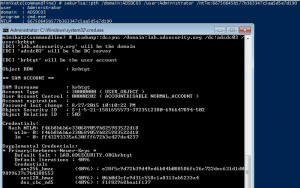The content in this post describes a method by which an attacker could persist administrative access to Active Directory after having Domain Admin level rights for 5 minutes. I presented on this AD persistence method at DerbyCon (2015). I also presented and posted on DSRM as a persistence method previously. Complete list of Sneaky Active …
Tag: WindowsServer2012R2
Jan 22 2015
Group Policy Settings Reference for Windows 8.1 and Windows Server 2012 R2
These spreadsheets list the policy settings for computer and user configurations that are included in the Administrative template files delivered with the Windows operating systems specified. You can configure these policy settings when you edit Group Policy Objects. The Group Policy Settings reference for Windows & Windows Server can be downloaded here. Here are …
Jan 14 2015
Windows Server 2012 & Windows Server 2012 R2 Complete Documentation
Microsoft took all the Windows Server 2012 (& 2012 R2) documentation and posted it as a single PDF! Version: 1.0 File Name: WS12_R2_and_WS12_TechNet.pdf Date Published: 2/18/2014 File Size: 125.9 MB This download is an Adobe® PDF of the entire contents of the Windows Server 2012 R2 and Windows Server 2012 section of the Microsoft TechNet …
Nov 21 2014
Microsoft KB2871997: Back-Porting Windows 8.1/Win2012R2 Enhanced Security & Pass The Hash Mitigation to Windows 7, Windows 8, & Windows 2008R2
In June 2014, Microsoft released KB2871997 which takes many of the enhanced security protection mechanisms built into Windows 8.1 & Windows Server 2012 R2 and “back-ports” them to Windows 7, Windows 8, Windows Server 2008R2, and Windows Server 2012. The enhanced security features reduce the credential data stored in memory and supports modern authentication (Kerberos …
Oct 29 2014
Windows Server 2012 R2 deprecates FRS (File Replication Service)
Microsoft’s Tip of the Day has the following useful information on Domain Controller File Replication Service (FRS) depercation: FRS (File Replication Service) has been deprecated in Windows Server 2012 R2. The deprecation of FRS has been accomplished by enforcing a minimum domain functional level of Windows Server 2008. This enforcement is present only if the …
Oct 14 2014
New & Updated Features in Windows Server 2012 R2
New & Updated Features in Windows Server 2012 R2 Expanded from: http://technet.microsoft.com/en-us/library/dn250019 What’s New for iSCSI Target Server in Windows Server 2012 R2 iSCSI Target Server enables you to network boot multiple computers from a single operating system image that is stored in a centralized location. iSCSI Target Server can boot hundreds of computers by …
Jul 24 2014
Authentication Problems in an Environment with Windows Server 2003 and Windows Server 2012 R2 Domain Controllers
Why this happens: The Kerberos client depends on a “salt” from the KDC in order to create the AES keys on the client side. These AES keys are used to hash the password that the user enters on the client, and protect it in transit over the wire so that it can’t be intercepted and …


Recent Comments